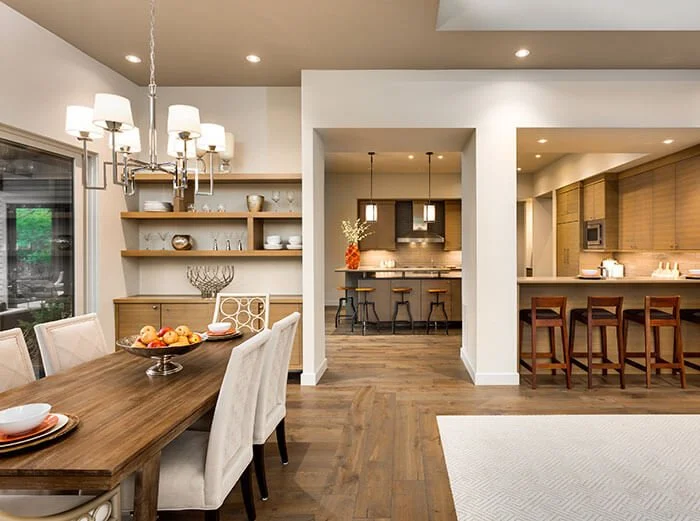Be More Mindful Of Our Consuming Practices and Fast Furniture
We’ve been bombarded with the adjective “fast” in our everyday lives. You might have seen posts on social media, news outlets, or blogs using “fast” to describe fashion, food, and furniture.
But what is it? What is fast furniture? Why is it so bad?
Let us preface by saying that purchasing fast fashion, including fast furniture, is something that is often unavoidable. That’s okay!
However, it should be avoided whenever possible. In this article, we will try to make you more aware of fast fashion as well as our overall approach to our lifestyle.
If we can be more mindful of our consuming habits, we can encourage others to do the same.
Through being mindful of our spending habits and maintenance of our furniture, we can begin to learn looks and styles that we genuinely love. We don’t have to switch up our entire house to fit a trend - we all have our own unique styles.
Here is a breakdown of what fast furniture is and how we can be more mindful of our consuming practices when it comes to what we buy.
What is Fast Furniture?
Let’s start by breaking down exactly what fast furniture is.
What is Fast Furniture?
Fast furniture is cheap, mobile, and easy to break down. This is what makes it so attractive to consumers. Not only that, but it is able to shift with the current trends easily. No matter your lifestyle, fast furniture has the perfect piece to match you at a cheaper price.
For example, minimalism might have been the trend recently for home decor, but now the tides seem to be shifting in favor of art deco. This isn’t a problem for producers of fast furniture. They can quickly and easily pump out sofas, dining tables, and other items to match the quickly changing trends.
Fast furniture items are usually made from different plastic materials such as laminate or veneers that constrain harmful chemicals like formaldehyde. This could lead to health problems later down the road if there is a good amount of furniture with laminate or veneers in the material.
This is how manufacturers like IKEA can put out so much furniture at once.
So, what’s the problem?
Because of the changing seasons and trends, some people, understandably, want their home to look up to par. Who doesn’t?
The problem is that furniture takes up a huge portion of what is thrown in landfills. According to the EPA, Americans throw out over 12 million tons of furniture items each year. Fast furniture keeps feeding into this “throwaway” culture because of how much is produced and how it is marketed.
Additionally, fast furniture exploits natural resources like wood, precious minerals, metal, and forestry products that could be used for long-lasting furniture.
So, what can we personally do to be conscious consumers?
Here is a helpful guide to what fast fashion is and how we can build a home that lasts.
The Shift Away From Fast
Sometimes, buying fast furniture is unavoidable. You can’t deny the cost and convenience of the products. Designer furniture is expensive and overpriced in some cases, so there is no shame in buying fast furniture.
The Shift Away From Fast Furniture
What we can do is be more conscious of what we are buying, how much we are buying, and how we manage what we buy.
Society today flourishes on constantly shifting ideas, trends, and lifestyles. Marketing profits off of telling us that our styles aren’t good enough and that we need “this thing” or “that thing” to make us happy and successful. Producers of fast fashion market their products to us the same way. This is in addition to telling us that we can get the same look of designer furniture for cheaper.
As the world becomes more conscious of the consequences of fast fashion, larger companies are ramping up their sustainability initiatives.
For example, IKEA is working hard to make sure their furniture doesn’t end up in landfills. They have launched several sustainability initiatives to discourage consumers from contributing to furniture waste. They have also provided disassembly instructions for their furniture so you can easily store and organize your furniture with the changing seasons.
Other manufacturers of furniture have partnered with sustainability companies to create new, environment-friendly furniture lines, or to raise awareness of furniture pollution.
Furniture manufacturers like IKEA are also creating furniture that is reusable and recyclable. This means getting rid of those toxic plastics and chemicals that harm us and the environment. Recycle initiatives are sprouting up in furniture stores everywhere in an effort to encourage at-home sustainability.
Upcyclers have also been advertising their businesses on social media to help people give their furniture a second life.
The incentive to limit the amount of fast furniture is there. As a community, we can make a difference to better our homes while making them look amazing too.
Fast Furniture Doesn’t Last
Fast Furniture Does Not Last, Quality Made Furniture Does
There is a reason why fast furniture is so easy to throw out. Because most items that are produced this way are made of laminate or veneers, they break easily. Plastics in furniture make it more susceptible to cracks and overall breakage.
This furniture won’t be able to withstand normal wear and tear.
If you have young kids, the furniture will most likely not hold up against bumps, scrapes, and sticky messes in the long run.
Fast furniture is not designed to be repainted and refurbished; it is designed to be thrown away. Even if you wanted to put a fresh coat of paint on one of your furniture items, it would still not hold up to the test of time.
This type of furniture is designed to last for about one to two years max in good condition. After the two-year mark, you might start seeing large cracks, chips in the paint, etc, and will have to replace it.
In the long run, you might end up spending more money on fast furniture than you would a sustainable and natural piece of furniture. Pursuing a “cheaper” lifestyle in this way will end up costing more in the long run.
Fast Furniture Adds To The Landfill Waste
Did we mention that fast furniture is made to be disposable?
Fast Furniture Adds To The Landfill
Americans alone throw out over 12 million tons of furniture a year. Other countries have similar numbers. Hundreds of thousands of mattresses, sofas, bed frames, and dining tables are simply thrown out without much regard to how it builds up in landfills.
Most, if not all, of this furniture, can not be recycled because of the plastics and fibers in the material. This means that furniture just sits there for ages.
Some of the materials can’t be properly burned because of the formaldehyde in the products.
The timber that is used in fast furniture is sealed and coated with Scotchguard or other chemical protectants that prevent it from being recycled.
Landfills are already filled to the brim because a lot of society leads purge consumer lifestyles. Furniture takes up so much of that landfill even though it might be perfectly fine for the time being.
Instead of donating, repurposing, or simply disassembling the furniture, most of it ends up in the landfill.
Other Concerns With Fast Furniture and Alternatives
Concerns with Fast Furniture
There are many concerns about fast furniture, but here are a few as well as some alternatives to buying fast.
Some furniture is not ethically manufactured. In other words, the reason why fast furniture is so cheap is that some companies might exploit their laborers in wages in addition to using the cheapest materials to make said products.
Looking into a manufacturer before buying products from them is one of the many ways to be conscious about our consumer lifestyle.
For example, looking at how much material is wasted or how much CO2 is being emitted from certain factories is a good way to know if a company is aligned with your environmental conscience.
Additionally, fast furniture is not healthy for our homes. We mentioned formaldehyde previously in this article as well as the other plastics some fast furniture manufacturers use for their products. This can potentially be dangerous for your health especially if these chemicals are in furniture items you use all the time such as a bed or sofa.
Keeping an eye out for furniture that is all-natural is a great way to avoid these chemicals and plastics. You can look at furniture that is made from hardwood or steel. Either of these natural alternatives is long-lasting as well so you don’t have to worry about throwing them out after a year. You can head over to your local furniture store or thrift shop to see if they have any stylish, naturally-made items for your home.
Luckily, there are many alternatives to fast fashion that are affordable and great for your home.
If you want to start the search for natural, sustainable furniture, start with your community! Thrift shops, garage sales, upcyclers, and local artisans usually have amazing furniture that has been repurposed or has the potential to be. Some of these alternatives are cheaper as well like shopping secondhand.
It is worth your while to find someone who can repurpose your old furniture or give new life to it.
If you would like to change the furniture in your house but don’t want to buy just any piece off of the internet, you can give your natural, long-lasting furniture new paint or fabric.
The most fun and sure-fire way to buy furniture that isn’t fast are to spend time figuring out your style. What colors and color palettes do you like? Are you more of a minimalist or art deco person? Whatever it is, take some time to figure out what you think looks best for your home.
Doing this before buying anything for your home will help you be more decisive about the pieces you want. As a result, you can eventually have a timeless, classic collection of furniture that will be a part of your home for the years to come.
Slowing down our consumerism lifestyles can be beneficial for our homes.
Fast Furniture Is More About Our Environment and Our Mindset as a Society
Why It Matters
Fast furniture is not just about the furniture. It’s about the environment and our mindset as a society.
It is overwhelming to look at what others have and think that we need more to satisfy ourselves and others around us. When it comes to our homes, a lot of us want it to look and feel like home especially to guests that walk in our front door.
The good news is, we do not have to adjust our lifestyles to adjust to the fast-paced demands of society. We can take the time to find what is right for us.
That may sound a little dramatic, but it’s true.
What we buy affects the outside world too. We can see that in the landfills overflowing with tables and bed frames. We can see that in the chemicals hiding within the wood of our bookshelves.
We can make a difference, not only in our own homes but in our communities too.
Buying locally increases demand for a certain product that small business makes. In turn, our local small businesses can thrive and the fast furniture business won’t have a need to produce cheap and disposable furniture anymore.
Buying fast furniture matters because it truly does affect all of us.
Shop Local and Redesign Your Living Space With Quality Furniture
Again, this article is not to scare you into buying insanely expensive furniture or to shame you for buying fast furniture. As stated previously, sometimes it can’t be helped.
However, all of us can make a difference if we desire to.
Let’s start by letting go of the pressure to adhere to certain trends. They are always going to change and they are going to change fast. Once you have your minimalist living room put together, farmhouse chic will be on the rise.
Take a step back and figure out what you like. It can be super fun finding out what makes your house feel like a home.
If you’re not inclined to figure out the design of your house by yourself, it might be worthwhile to consider an interior designer or enlist the help of a friend. Watching your house being put together with the furniture you know will last can be a fulfilling experience.
Consider looking locally for furniture and don’t be afraid to slow down to figure out what you like!
Take it one step at a time. Happy furniture hunting!
Jessica Lauren is Founder, contributing Author and Owner of Citrus Sleep. Citrus Sleep is an online publication that highlights brands, sleep products, women’s fashion, subscription services and ideas creating positive social change and promoting a healthy lifestyle. After spending nearly a decade working in PR and marketing for several brands and startups, Jessica knows what truly drives conversions, sold-out launches and guest posts.
Follow Jessica at @jessicalaurencs | Jessica Lauren


















